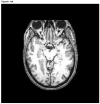Preventing facial recognition when rendering MR images of the head in three dimensions
- PMID: 18069044
- PMCID: PMC2504704
- DOI: 10.1016/j.media.2007.10.008
Preventing facial recognition when rendering MR images of the head in three dimensions
Abstract
In the United States it is not allowed to make public any patient-specific information without the patient's consent. This ruling has led to difficulty for those interested in sharing three-dimensional (3D) images of the head and brain since a patient's face might be recognized from a 3D rendering of the skin surface. Approaches employed to date have included brain stripping and total removal of the face anterior to a cut plane, each of which lose potentially important anatomical information about the skull surface, air sinuses, and orbits. This paper describes a new approach that involves (a) definition of a plane anterior to which the face lies, and (b) an adjustable level of deformation of the skin surface anterior to that plane. On the basis of a user performance study using forced choices, we conclude that approximately 30% of individuals are at risk of recognition from 3D renderings of unaltered images and that truncation of the face below the level of the nose does not preclude facial recognition. Removal of the face anterior to a cut plane may interfere with accurate registration and may delete important anatomical information. Our new method alters little of the underlying anatomy and does not prevent effective registration into a common coordinate system. Although the methods presented here were not fully effective (one subject was consistently recognized under the forced choice study design even at the maximum deformation level employed) this paper may point a way toward solution of a difficult problem that has received little attention in the literature.
Figures





















References
-
- Chellappa R, Wilson CL, Sirohey S. Human and Machine Recognition of Faces: A Survey. Proceeding of the IEEE. 1995;83:705–740.
-
- HIPAA Privacy Rules. 2006. Available at http://privacyruleandresearch.nih.gov/pr_08.asp.
-
- Ibañez L, Schroeder W, Ng L, Cates J. The ITK Software Guide. Second. Kitware Inc; 2005.
-
-
ICBM Atlas, McConnell Brain Imaging Centre, Montréal Neurological Institute, McGill University, Montréal, Canada.
-
-
- Jomier J, Guyon JP, Aylward S, et al. The Spatial Object Viewers Toolkit. http://public.kitware.com/SOViewer.
Publication types
MeSH terms
Grants and funding
LinkOut - more resources
Full Text Sources
Other Literature Sources
Medical

